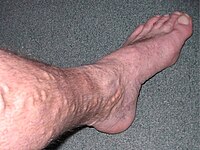
Photo from wikipedia
OBJECTIVES We evaluated and compared midterm recurrence results of our patients with great saphenous vein insufficiency who were treated with a 1470-nm diode laser using 2 different types of fibre… Click to show full abstract
OBJECTIVES We evaluated and compared midterm recurrence results of our patients with great saphenous vein insufficiency who were treated with a 1470-nm diode laser using 2 different types of fibre catheter kits. METHODS A total of 61 consecutive patients were treated between 2013 and 2014 with a bare fibre (BF) tip (BF group) and 60 consecutive patients were treated with a radial fibre (RF) tip (RF group) from 2014 to 2016. First-year venous clinical severity scores (VCSSs) were compared with VCSS before endovenous laser ablation and at the first-month follow-up. Patients were examined for recurrence and classified according to the system developed by Stonebridge. RESULTS There was no significant difference between the 2 groups in terms of VCSS. Examination with Doppler ultrasonography showed no recurrence in the RF group, whereas recurrences were detected in 6 patients in the BF group, which was statistically significant (P = 0.028). All of the recurrences were type 1b (incompetent tributaries) varicose vein recurrences. The VCSS of the patients with recurrence were the same as the scores of patients without recurrence (0.5 ± 0.55). CONCLUSIONS Varicose vein recurrence was more often seen in the BF group than in the RF group. Recanalization-induced and neovascularization-induced recurrences were not found in either group. Saphenofemoral side branch-induced recurrence was more significant in the group treated with the BF tip.
Journal Title: Interactive cardiovascular and thoracic surgery
Year Published: 2020
Link to full text (if available)
Share on Social Media: Sign Up to like & get
recommendations!